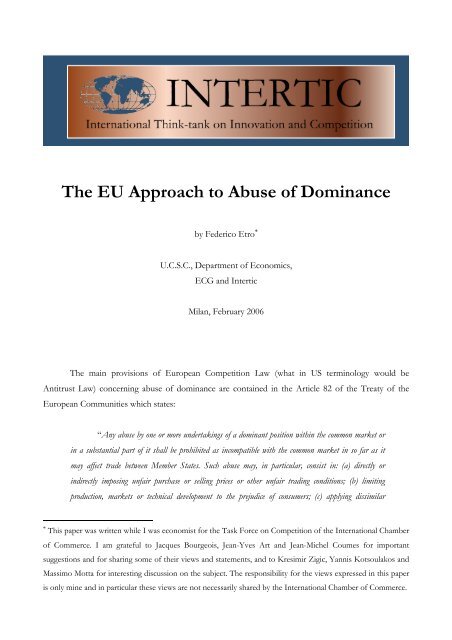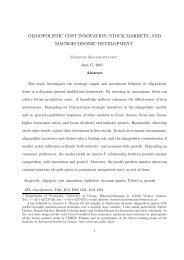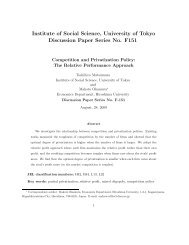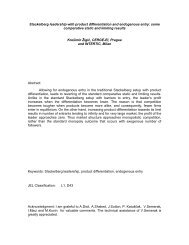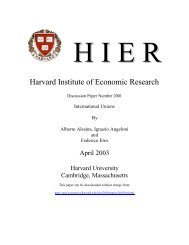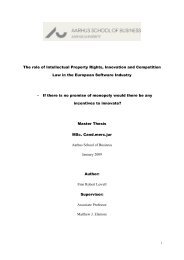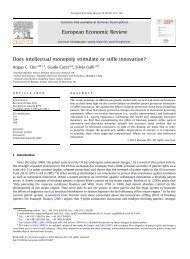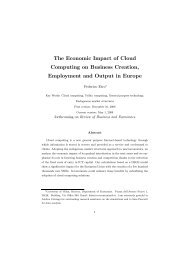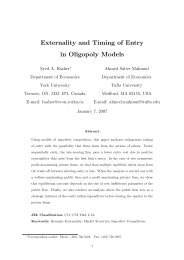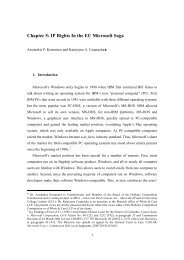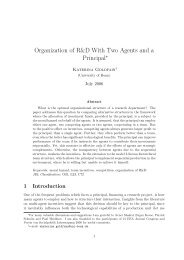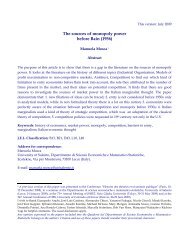The EU Approach to Abuse of Dominance - Intertic
The EU Approach to Abuse of Dominance - Intertic
The EU Approach to Abuse of Dominance - Intertic
You also want an ePaper? Increase the reach of your titles
YUMPU automatically turns print PDFs into web optimized ePapers that Google loves.
<strong>The</strong> <strong>EU</strong> <strong>Approach</strong> <strong>to</strong> <strong>Abuse</strong> <strong>of</strong> <strong>Dominance</strong><br />
by Federico Etro ∗<br />
U.C.S.C., Department <strong>of</strong> Economics,<br />
ECG and <strong>Intertic</strong><br />
Milan, February 2006<br />
<strong>The</strong> main provisions <strong>of</strong> European Competition Law (what in US terminology would be<br />
Antitrust Law) concerning abuse <strong>of</strong> dominance are contained in the Article 82 <strong>of</strong> the Treaty <strong>of</strong> the<br />
European Communities which states:<br />
“Any abuse by one or more undertakings <strong>of</strong> a dominant position within the common market or<br />
in a substantial part <strong>of</strong> it shall be prohibited as incompatible with the common market in so far as it<br />
may affect trade between Member States. Such abuse may, in particular, consist in: (a) directly or<br />
indirectly imposing unfair purchase or selling prices or other unfair trading conditions; (b) limiting<br />
production, markets or technical development <strong>to</strong> the prejudice <strong>of</strong> consumers; (c) applying dissimilar<br />
∗ This paper was written while I was economist for the Task Force on Competition <strong>of</strong> the International Chamber<br />
<strong>of</strong> Commerce. I am grateful <strong>to</strong> Jacques Bourgeois, Jean-Yves Art and Jean-Michel Coumes for important<br />
suggestions and for sharing some <strong>of</strong> their views and statements, and <strong>to</strong> Kresimir Zigic, Yannis Kotsoulakos and<br />
Massimo Motta for interesting discussion on the subject. <strong>The</strong> responsibility for the views expressed in this paper<br />
is only mine and in particular these views are not necessarily shared by the International Chamber <strong>of</strong> Commerce.
conditions <strong>to</strong> equivalent transactions with other trading parties, thereby placing them at competitive<br />
disadvantage; (d) making the conclusion <strong>of</strong> contracts subject <strong>to</strong> acceptance by other parties <strong>of</strong><br />
supplementary obligations which, by their nature or according <strong>to</strong> commercial usage, have no connection<br />
with the subject <strong>of</strong> such contracts.”<br />
This article (as Article 81 on horizontal and vertical agreements) is part <strong>of</strong> the law <strong>of</strong> each<br />
member state and is enforced by the European Commission (in particular the Direc<strong>to</strong>rate General for<br />
Competition) and by all the National Competition Authorities. 1<br />
<strong>The</strong> application <strong>of</strong> <strong>EU</strong> competition law on abuse <strong>of</strong> dominance involves the finding <strong>of</strong> a<br />
dominance position and <strong>of</strong> an abusive behaviour <strong>of</strong> the dominant firm, usually associated with excessive<br />
pricing or with exclusionary practices as preda<strong>to</strong>ry pricing, rebates, tying or bundling, exclusive dealing or<br />
refusal <strong>to</strong> supply. However, the analysis <strong>of</strong> both dominance and abusive behaviours entail complex<br />
economic considerations and has been subject <strong>to</strong> a recent revision. <strong>The</strong> European Commission<br />
published, in December 2005, a Discussion Paper 2 on exclusionary abuses under Article 82 (hence on,<br />
the Discussion Paper) which is the subject <strong>of</strong> an open debate and gives an important indication as <strong>to</strong><br />
how the Commission may approach exclusionary abuses in the future. <strong>The</strong> Discussion Paper states that<br />
the purpose <strong>of</strong> Article 82 is “the protection <strong>of</strong> competition on the market as a means <strong>of</strong> enhancing<br />
consumer welfare and <strong>of</strong> ensuring an efficient allocation <strong>of</strong> resources” (# 4). 3 This implies that antitrust<br />
should protect competition and not competi<strong>to</strong>rs and be based on an economic approach aiming at the<br />
maximization <strong>of</strong> consumer welfare and allocative efficiency rather than based on a legalistic approach.<br />
In the current proposal <strong>of</strong> the guidelines for <strong>EU</strong> antitrust there are some positive aspects, mainly<br />
in the central concern <strong>to</strong> enhance consumer welfare and <strong>to</strong> protect competition and not competi<strong>to</strong>rs, but<br />
such a welfare-based approach is not enough supported in the overall design <strong>of</strong> these guidelines.<br />
In what follows, we will review the <strong>EU</strong> approach <strong>to</strong> competition law regarding abuse <strong>of</strong><br />
dominance in the general terms concerning the definition <strong>of</strong> dominance and the objectives <strong>of</strong> antitrust,<br />
and with references <strong>to</strong> the main cases <strong>of</strong> abusive conduct, and I will provide an evaluation <strong>of</strong> the<br />
Discussion Paper.<br />
1 At the <strong>EU</strong> level, the Court <strong>of</strong> First Instance has jurisdiction in all actions brought against the decisions <strong>of</strong> the<br />
Commission, while the European Court <strong>of</strong> Justice decides on appeal actions brought against the judgments <strong>of</strong><br />
the Court <strong>of</strong> First Instance.<br />
2 DG Competition Discussion Paper on the Application <strong>of</strong> Article 82 <strong>of</strong> the Treaty <strong>to</strong> Exclusionary <strong>Abuse</strong>s, Bruxelles,<br />
December 19, 2005.<br />
3 <strong>The</strong> Discussion Paper only deals with exclusionary abuses under Article 82 EC. It does not deal with<br />
exploitative abuses and discrimina<strong>to</strong>ry practices.<br />
2
1. Market definition and dominance<br />
According <strong>to</strong> the European Competition Law, dominance in a market or its creation cannot be<br />
punished, while only its abuse by dominant firms is subject <strong>to</strong> antitrust screening. Hence, the<br />
preliminary phase <strong>of</strong> any antitrust case applying Article 82 must define the relevant market and verify<br />
the existence <strong>of</strong> a dominant position. <strong>The</strong> Discussion Paper briefly refers <strong>to</strong> the definition <strong>of</strong> a proper<br />
market, which can be more complex in Article 82 cases because the market price could be above its<br />
competitive level (#11-19). This creates problems with the usual methods <strong>of</strong> market definition. For<br />
instance the SSNIP-test, which defines the relevant separate market as the smallest market where a Small<br />
but Significant Non-transi<strong>to</strong>ry Increase in (competitive) Prices (say <strong>of</strong> 5-10%) increases the pr<strong>of</strong>its <strong>of</strong> a<br />
hypothetical monopolist, is biased when the market is characterized by higher than competitive prices<br />
(which is more likely in cases <strong>of</strong> abuse <strong>of</strong> dominance): such a bias usually leads <strong>to</strong> a <strong>to</strong>o-wide market<br />
definition, which in turn may lead <strong>to</strong> a finding <strong>of</strong> no dominance, the so-caled “cellophane fallacy” (from<br />
the du Pont case).<br />
It should be noticed that the cellophane fallacy only applies in presence <strong>of</strong> a single monopolist<br />
in the market and when entry is impossible, while the SSNIP-test at the prevailing prices remains a<br />
valid test whenever the market leader is constrained by effective competition and/or potential entry.<br />
Following a traditional definition, 4 the Discussion Paper associates dominance with “a position<br />
<strong>of</strong> economic strength enjoyed by an undertaking which enables it <strong>to</strong> prevent effective competition<br />
being maintained on the relevant market by affording it the power <strong>to</strong> behave <strong>to</strong> an appreciable extent<br />
independently <strong>of</strong> its competi<strong>to</strong>rs, its cus<strong>to</strong>mers and ultimately <strong>of</strong> the consumers” (# 20). Such a<br />
definition requires “a leading position on that market” compared <strong>to</strong> the rivals (# 22) and the lack <strong>of</strong><br />
“effective competitive constraints” (# 23) in the process in which “the undertaking and the other<br />
players act and inter-act on the market”( # 23).<br />
Given the positive stress put on an economic-based approach <strong>to</strong> competition policy, it is<br />
important <strong>to</strong> notice that this definition <strong>of</strong> dominance is clearly associated with two situations examined<br />
by economic analysis: the pure monopoly, as an extreme case <strong>of</strong> dominance, and the market leadership<br />
where the dominant firm faces some competi<strong>to</strong>rs, which is clearly the most interesting case. It should<br />
be emphasized that, according <strong>to</strong> standard economic analysis, a market leader can really act<br />
independently <strong>of</strong> its rivals (so as <strong>to</strong> satisfy the above condition for dominance) 5 only when the number<br />
<strong>of</strong> competi<strong>to</strong>rs is exogenously set and further entry is impossible, while a market leadership constrained<br />
by effective competition and potential entry cannot be associated with dominance: in this case, the<br />
modern theory <strong>of</strong> market leaders tells us that leaders tend <strong>to</strong> be aggressive (pro-competitive) in their<br />
4 Case 85/76 H<strong>of</strong>fmann-La Roche, ECR 461, 34-5, 118n27, 499 n122.<br />
5 And potentially it can implement anticompetitive strategies, that is engage in abusive conduct.<br />
3
pricing and investment strategies, conquering larger market shares in a way that has nothing <strong>to</strong> do with<br />
dominance as defined above, and which is also beneficial <strong>to</strong> consumers. 6<br />
As a consequence <strong>of</strong> the approach <strong>of</strong> the Discussion Paper, it would be better <strong>to</strong> eliminate a<br />
certain ambiguity in the statement at # 27 saying that “the fact that an undertaking is compelled by the<br />
pressure <strong>of</strong> its competi<strong>to</strong>rs’ price reductions <strong>to</strong> lower its own prices is in general incompatible with […]<br />
the existence <strong>of</strong> substantial market power” and hence with dominance. In particular this should be<br />
always true and not just “in general”, since in this case the market leader is constrained by effective<br />
competition and cannot act independently from it, as the definition <strong>of</strong> dominance would require and<br />
should be extended <strong>to</strong> any other form <strong>of</strong> aggressive competition, that is not only competition in prices,<br />
but also competition in quantities or in alternative forms <strong>of</strong> strategic investments. Hence, the fact that<br />
an undertaking is compelled by the pressure <strong>of</strong> its competi<strong>to</strong>rs’ aggressive strategies <strong>to</strong> adopt aggressive<br />
(pricing and investment) strategies should be always incompatible with dominance.<br />
<strong>The</strong> stress on market shares in the evaluation <strong>of</strong> dominance (# 29- 33) appears in clear contrast<br />
with the conclusions <strong>of</strong> the modern theory <strong>of</strong> market leadership: market leaders have larger market<br />
shares exactly when they are constrained by effective and potential competition since in this case they<br />
adopt more aggressive (pricing and investment) strategies which expand their market shares. In other<br />
words there is not necessarily a positive correlation between the presence <strong>of</strong> larger market shares and a<br />
dominant position and, especially in highly dynamic markets, there is not unambiguous theoretical<br />
support for a statement saying that “[m]arket share is only a proxy for market power” (# 32). As a<br />
recent DG Competition’s study on Article 82 7 has correctly pointed out, “the case law tradition <strong>of</strong><br />
having separate assessments <strong>of</strong> dominance and <strong>of</strong> abusiveness <strong>of</strong> behavior simplifies procedures, but<br />
this simplification involves a loss <strong>of</strong> precision in the implementation <strong>of</strong> the legal norm. <strong>The</strong> structural<br />
indica<strong>to</strong>rs which traditionally serve as proxies for ‘dominance’ provide an appropriate measure <strong>of</strong><br />
power in some markets, but not in others”, as indeed in high-tech and New Economy industries (as<br />
computer hardware and s<strong>of</strong>tware, online businesses, mobile telephony and biotechnology).<br />
Finally, the part on dominance clearly refers <strong>to</strong> competition in the market, while it is hardly<br />
useful <strong>to</strong> evaluate cases where competition for the market takes place. In these cases, typical <strong>of</strong> the New<br />
6 See Franco Modigliani (1958, “New Developments on the Oligopoly Front”, Journal <strong>of</strong> Political Economy, 66, 3,<br />
June, pp. 215-32) and Federico Etro (2006, “Aggressive Leaders”, Rand Journal <strong>of</strong> Economics, Vol. 37, Spring, pp.<br />
1-10; 2006, “Competition Policy: Toward a New <strong>Approach</strong>”, European Competition Journal, Vol. 2, March, pp. 21-<br />
47). This theory is strictly related with the pathbreaking work on contestable markets by William Baumol, John<br />
Panzar and Robert Willig, Contestable Markets and the <strong>The</strong>ory <strong>of</strong> Industry Structure, New York: Harcourt Brace<br />
Jovanovich, 1982.<br />
7 Patrick Rey (Coordina<strong>to</strong>r), Report by the EAGCP ‘An Economic <strong>Approach</strong> <strong>to</strong> Article 82’”, July, 2005.<br />
4
Economy, competition is dynamic and innova<strong>to</strong>rs conquer large parts <strong>of</strong> a market, so that any static<br />
analysis <strong>of</strong> market shares cannot say anything about dominance. In other words, a market can be<br />
currently dominated by a single firm, but if many other firms which are not even active in this market<br />
are investing in R&D <strong>to</strong> enter in<strong>to</strong> it, as it happens in many high-tech sec<strong>to</strong>rs, this market is<br />
substantially competitive in a dynamic sense. Nevertheless, any leader in such a competitive winnertakes-all<br />
market would be always characterized as dominant by the static and market-share-based<br />
approach <strong>of</strong> the Discussion Paper.<br />
Moreover, modern economic theory tells us that in these dynamic sec<strong>to</strong>rs market leaders, as<br />
long as they are constrained by effective competition in the market for innovations, invest more than<br />
their competi<strong>to</strong>rs and hence are more likely <strong>to</strong> remain leaders. 8 In this sense, statements saying that<br />
“high market shares, which have been held for some time, indicate a dominant position” can be true in<br />
some sec<strong>to</strong>rs, but not in high-tech sec<strong>to</strong>rs with competition for the market. In conclusion, the general<br />
impression is that there is an excessive stress on the importance <strong>of</strong> market shares <strong>to</strong> evaluate<br />
dominance, and that this can be highly misleading especially for dynamic markets.<br />
<strong>The</strong> part on barriers <strong>to</strong> expansion and entry (# 34-40) concerns a concept which is far from<br />
unambiguous in economic theory. <strong>The</strong> definition <strong>of</strong> these barriers as “fac<strong>to</strong>rs that make entry<br />
impossible or unpr<strong>of</strong>itable while permitting established undertakings <strong>to</strong> charge prices above the<br />
competitive level” (# 38) applies well <strong>to</strong> legal barriers but not <strong>to</strong> other fac<strong>to</strong>rs which are sometimes<br />
seen as barriers. For instance, high fixed costs <strong>of</strong> production and R&D or investments needed <strong>to</strong><br />
develop network externalities or learning by doing advantages, do not make entry impossible: the<br />
correct definition in these cases would be that these fac<strong>to</strong>rs endogenously limit entry or endogenously<br />
determine how many and which firms pr<strong>of</strong>itably enter. <strong>The</strong> difference is not just in the definition but<br />
also in the economic consequence, since modern economic theory has shown that when entry is<br />
impossible market leaders may behave in an anti-competitive way, but when entry is constrained by<br />
technological or demand conditions they (always) behave in a pro-competitive way even if the cited<br />
fac<strong>to</strong>rs limit entry and the market leaders obtain high market shares.<br />
2. <strong>The</strong> principles <strong>of</strong> <strong>EU</strong> antitrust<br />
Despite the Discussion Paper claims that “the purpose <strong>of</strong> Article 82 is not <strong>to</strong> protect<br />
competi<strong>to</strong>rs from dominant firms’ genuine competition based on fac<strong>to</strong>rs such as higher quality, novel<br />
products, opportune innovation or otherwise better performance, but <strong>to</strong> ensure that these competi<strong>to</strong>rs<br />
8 See Etro (2004, “Innovation by Leaders”, Economic Journal, Vol. 114, 495, April, pp. 281-310).<br />
5
are also able <strong>to</strong> expand in or enter the market and compete therein on the merits, without facing<br />
conditions which are dis<strong>to</strong>rted or impaired by the dominant firm.” (# 54), these principles are not fully<br />
carried through in<strong>to</strong> certain aspects <strong>of</strong> the analytic framework. In particular, it would be better <strong>to</strong> stress<br />
more that the interests <strong>of</strong> consumers are always paramount <strong>of</strong> those <strong>of</strong> competi<strong>to</strong>rs, <strong>to</strong> move even<br />
further away from form-based rules and presumptions <strong>to</strong>wards a more economics- and fact-based<br />
approach, and <strong>to</strong> expand the avenues through which account may be taken <strong>of</strong> the efficiency-enhancing<br />
effects <strong>of</strong> challenged conduct. <strong>The</strong> analysis <strong>of</strong> whether a firm has engaged in abusive conduct under<br />
Article 82 should ultimately turn on the conduct’s actual effects on efficiency and consumer welfare.<br />
Thus, if the pro-consumer benefits <strong>of</strong> a dominant undertaking’s conduct are significant, it should be<br />
immune from liability even if it disadvantages certain competi<strong>to</strong>rs: inventing better products or more<br />
efficient methods <strong>of</strong> distribution, reducing prices or <strong>of</strong>fering better terms <strong>of</strong> trade, and more quickly<br />
adapting <strong>to</strong> changes in the market can disadvantage rivals and maybe even cause them <strong>to</strong> exit the<br />
market, but these forms <strong>of</strong> conduct <strong>of</strong>ten also enhance efficiency and consumer welfare. 9<br />
In spelling out the concept <strong>of</strong> foreclosure, the Discussion Paper states that “it is sufficient that<br />
the rivals are disadvantaged and consequently led <strong>to</strong> compete less aggressively” (# 58). This proposition<br />
gives cause for concern. First, this statement is not consistent with standard economic theory which has<br />
made clear that an aggressive behaviour <strong>of</strong> the market leader inducing a less aggressive competition <strong>of</strong><br />
its competi<strong>to</strong>rs is not sufficient <strong>to</strong> create any harm <strong>to</strong> consumers (actually the net effect is typically the<br />
opposite happens). 10 <strong>The</strong> inconsistency <strong>of</strong> this statement is even more clear when it is claimed that<br />
9 This focus is particularly important with respect <strong>to</strong> fast-moving markets such as those commonly found in<br />
high-tech and New Economy industries. <strong>The</strong>se industries are <strong>of</strong>ten characterised by massive R&D investments,<br />
strong reliance on IPRs and other intangible assets, network effects, high fixed sunk costs and low marginal<br />
costs. Competition in these markets is dynamic in the sense that competition <strong>of</strong>ten takes place for the market in<br />
a “winner-takes-all” race. Leading firms in these markets might enjoy high market shares yet be subject <strong>to</strong><br />
massive competitive pressure <strong>to</strong> constantly create better products at lower prices due <strong>to</strong> threats from innovative<br />
competi<strong>to</strong>rs and potential entrants. Companies that hold a significant share <strong>of</strong> the market at any given point <strong>of</strong><br />
time may see this share decrease rapidly and significantly following the development and supply <strong>of</strong> a new and<br />
more attractive product by an actual or potential competi<strong>to</strong>r. <strong>The</strong> launch <strong>of</strong> the iPod by Apple and its impact on<br />
the distribution <strong>of</strong> so-called “MP3 players” (small and light devices used for s<strong>to</strong>ring and playing digital music<br />
files) is a good example <strong>of</strong> such rapid and drastic market developments.<br />
10 As pointed out by well established economic doctrine (Drew Fundenberg. and Jean Tirole, 1985, “<strong>The</strong> Fat Cat<br />
Effect, the Puppy Dog Ploy and the Lean and Hungry Look”, American Economic Review, 74 , May, pp. 361-68), an<br />
aggressive behaviour <strong>of</strong> the market leader can lead <strong>to</strong> more aggressive competition by a competi<strong>to</strong>r (generally<br />
under competition in prices) or <strong>to</strong> a less aggressive one (typically under competition in quantities) with positive<br />
consequences for the consumers in the first case and only ambiguous ones in the second (see Williamson, O. E.,<br />
<strong>The</strong> Economic Institutions <strong>of</strong> Capitalism (New York, Free Press, 1985) for an early evaluation <strong>of</strong> this approach).<br />
6
“[r]ivals may be disadvantaged where the dominant company is able <strong>to</strong> … reduce demand for the rivals’<br />
products” (# 58) which is really what any aggressive or pro-competitive strategy would do. Putting<br />
<strong>to</strong>gether the two sentences, we are <strong>to</strong>ld that it would be sufficient <strong>to</strong> establish foreclosure that the<br />
strategy <strong>of</strong> the dominant firm reduces demand for the rivals’ product: but this amounts <strong>to</strong> banish any<br />
pro-competitive strategy by market leaders. Moreover, the above statement could arguably support the<br />
conclusion that a dominant company in a market characterized by network effects could be guilty <strong>of</strong><br />
abuse if it is able <strong>to</strong> attract new cus<strong>to</strong>mers on the basis <strong>of</strong> a new, superior technology. This view is<br />
contrary <strong>to</strong> the basic principle that dominant companies should be permitted (and indeed encouraged)<br />
<strong>to</strong> compete aggressively on the merits. Allowing a finding <strong>of</strong> abuse merely where competi<strong>to</strong>rs are<br />
“disadvantaged” would penalise dominant firms for engaging in a wide range <strong>of</strong> conduct that is<br />
ultimately pro-competitive. In our view, this aspect <strong>of</strong> the analytic framework should be revised <strong>to</strong><br />
clarify that conduct by a dominant firm would be deemed <strong>to</strong> be an abuse only if its net effect is <strong>to</strong> harm<br />
consumer welfare. 11<br />
<strong>The</strong> Discussion Paper states that the Commission may at times prohibit the use <strong>of</strong> price<br />
discounts where doing so will “protect competi<strong>to</strong>rs that are not (yet) as efficient as the dominant<br />
company” (# 67). In our view, there is no economic justification for barring dominant firms from<br />
decreasing prices simply in order <strong>to</strong> protect less efficient rivals (particularly since such a prohibition will<br />
mean that these rivals will face even less competitive pressure <strong>to</strong> become more efficient). This<br />
condition also places dominant firms in the untenable position <strong>of</strong> having <strong>to</strong> guess what level <strong>of</strong> rival<br />
inefficiency will be used <strong>to</strong> judge whether the dominant firm’s own efficiency-enhancing conduct is<br />
lawful. <strong>The</strong> Discussion Paper also states, in its discussion <strong>of</strong> the meeting competition defense, that a<br />
dominant firm has an obligation <strong>to</strong> weigh “the interests <strong>of</strong> its competi<strong>to</strong>rs <strong>to</strong> enter or expand” in<strong>to</strong> the<br />
market when deciding upon alternative courses <strong>of</strong> action, and that dominant firms can only benefit<br />
from this defence if they prove there was no less anticompetitive alternative (# 82-83). In the real<br />
world, the best businesses are focused on advancing the interests <strong>of</strong> their cus<strong>to</strong>mers, not their<br />
competi<strong>to</strong>rs (which, <strong>of</strong> course, is one sign <strong>of</strong> a competitive market). Thus, most dominant firms will be<br />
ill-equipped <strong>to</strong> evaluate which <strong>of</strong> various possible options will least disadvantage their competi<strong>to</strong>rs. We<br />
Moreover, when entry <strong>of</strong> competi<strong>to</strong>rs is endogenously taken in<strong>to</strong> account (which should be the relevant case), an<br />
aggressive behaviour <strong>of</strong> the leader does not affect each single competi<strong>to</strong>r but can reduce entry, with net effects<br />
for consumer welfare and allocation <strong>of</strong> resources which are always positive (Etro, 2006). Hence, an aggressive<br />
behaviour <strong>of</strong> the market leader inducing less aggressive competition <strong>of</strong> the competi<strong>to</strong>rs is not sufficient <strong>to</strong> create<br />
any harm <strong>to</strong> consumers or <strong>to</strong> deteriorate the allocation <strong>of</strong> resources.<br />
11 See, e.g., Commissioner Neelie Kroes, Preliminary Thoughts on Policy Review <strong>of</strong> Article 82, at 3 (23 Sept. 2005)<br />
(stating that, in the analysis <strong>of</strong> exclusionary conduct under Article 82, “ultimately the aim is <strong>to</strong> avoid consumers<br />
harm”).<br />
7
would therefore recommend that this requirement that dominant firms weigh the interests <strong>of</strong><br />
competi<strong>to</strong>rs be dropped from the analysis.<br />
<strong>EU</strong> Competition Law has been criticised for focusing more on the form <strong>of</strong> unilateral conduct<br />
than on its actual effects in the marketplace. <strong>The</strong>re is broad consensus among economists that<br />
(unilateral) price- and non-price conduct <strong>of</strong> dominant firms may produce both pro- and anticompetitive<br />
effects. <strong>The</strong> ambiguous nature <strong>of</strong> conduct <strong>of</strong> dominant firms militates in favour <strong>of</strong> a full appreciation <strong>of</strong><br />
the (positive and negative) effects on consumers. It is therefore vital that the framework for analysis<br />
under Article 82 provides for a rigorous, economics-based examination <strong>of</strong> the market context in which<br />
unilateral conduct occurs. For instance, the Commission should clarify that, despite the references <strong>to</strong><br />
the “form and nature” <strong>of</strong> conduct in the general discussion <strong>of</strong> exclusionary abuses (# 58-59), whether<br />
market foreclosure will be found <strong>to</strong> exist will ultimately turn on the actual effects <strong>of</strong> the conduct in the<br />
marketplace. Also, while we commend the Commission for placing less reliance on per se rules and<br />
irrebutable presumptions <strong>of</strong> market foreclosure and abuse, the Discussion Paper retains elements <strong>of</strong><br />
this approach. For example, in several places, certain forms <strong>of</strong> conduct or market shares will make it<br />
“highly unlikely” that some legal determination will result (# 30, 90, 91). We would urge the<br />
Commission <strong>to</strong> lessen its reliance even on these quasi-per se rules and <strong>to</strong> adopt a more thoroughgoing,<br />
economics- and effects-based analysis that focuses on increasing consumer welfare and is based on<br />
sound economic theory <strong>of</strong> the behaviour <strong>of</strong> market leaders and on solid empirical analysis. 12 <strong>The</strong> recent<br />
DG Competition’s study on Article 82 (Rey et al., Report by the EAGCP ‘An Economic <strong>Approach</strong> <strong>to</strong> Article<br />
12 Furthermore, we are not persuaded that an approach based on the weighing <strong>of</strong> pro- and anti-competitive<br />
effects will decrease legal certainty. Much <strong>of</strong> the current uncertainty about the boundaries between permissible<br />
and prohibited business practices results from a form-based approach <strong>to</strong> certain pricing practices and the<br />
difficulty inherent in such an approach in determining whether new kinds <strong>of</strong> economic activity should be<br />
regarded as being <strong>of</strong> one type <strong>of</strong> form or another. Form-based approaches lack consistent and rigorous analysis<br />
<strong>of</strong> the concrete effects <strong>of</strong> a given practice and <strong>of</strong>ten have the effect <strong>of</strong> condemning pr<strong>of</strong>it-maximizing conduct<br />
that benefits consumers. <strong>The</strong> uncertainty that results from the condemnation <strong>of</strong> conduct that may not have any<br />
significant impact on competition or that may benefit consumers creates added risks for business, which itself<br />
reduces efficiency, and deters undertakings from applying business practices (e.g. certain pricing schemes) which<br />
in fact increase competition and are beneficial for consumers.<strong>The</strong> recent DG Competition’s study on Article 82<br />
(Rey et al., Report by the EAGCP ‘An Economic <strong>Approach</strong> <strong>to</strong> Article 82,’” July 2005) correctly emphasizes the need <strong>of</strong><br />
solid theoretical and empirical foundations in the antitrust procedure: “a natural process would consist <strong>of</strong> asking<br />
the competition authority <strong>to</strong> first identify a consistent s<strong>to</strong>ry <strong>of</strong> competitive harm, identifying the economic<br />
theory or theories on which the s<strong>to</strong>ry is based, as well as the facts which support the theory as opposed <strong>to</strong><br />
competing theories. Next, the firm should have the opportunity <strong>to</strong> present its defense, presumably <strong>to</strong> provide a<br />
counter-s<strong>to</strong>ry indicating that the practice in question is not anticompetitive, but is in fact a legitimate, perhaps<br />
even pro-competitive business practice.”<br />
8
82,’” July 2005) correctly emphasizes the need <strong>of</strong> solid theoretical and empirical foundations in the<br />
antitrust procedure: “a natural process would consist <strong>of</strong> asking the competition authority <strong>to</strong> first<br />
identify a consistent s<strong>to</strong>ry <strong>of</strong> competitive harm, identifying the economic theory or theories on which<br />
the s<strong>to</strong>ry is based, as well as the facts which support the theory as opposed <strong>to</strong> competing theories.<br />
Next, the firm should have the opportunity <strong>to</strong> present its defense, presumably <strong>to</strong> provide a counters<strong>to</strong>ry<br />
indicating that the practice in question is not anticompetitive, but is in fact a legitimate, perhaps<br />
even pro-competitive business practice.”<br />
Conduct that generates efficiencies should not, in our view, be deemed abusive unless it is<br />
demonstrated that the impact <strong>of</strong> this conduct on competition will result in consumer harm outweighing<br />
these efficiencies. While the Discussion Paper acknowledges that promoting efficiency is one <strong>of</strong> the<br />
primary objectives <strong>of</strong> Article 82, the framework for analysis itself actually provides relatively limited<br />
scope for taking efficiencies in<strong>to</strong> account. This manifests itself in a variety <strong>of</strong> ways:<br />
First, the Discussion Paper indicates that, consistent with existing practice, it will fall on<br />
dominant firms <strong>to</strong> prove the extent <strong>to</strong> which their conduct was justified on grounds <strong>of</strong> efficiency (# 77,<br />
79). Bringing efficiencies in<strong>to</strong> the analysis only as an affirmative defense will send the wrong signal <strong>to</strong><br />
the business community: it means that investigations will <strong>of</strong>ten have moved quite far along before<br />
efficiency considerations fully come in<strong>to</strong> play. Placing the burden <strong>of</strong> pro<strong>of</strong> on competition authorities,<br />
by contrast, makes more sense as they are likely <strong>to</strong> be in a better position <strong>to</strong> obtain relevant evidence<br />
from the dominant firm as well as other market participants (such as consumer organizations) on<br />
whether challenged conduct promotes efficiency—and have the expertise and resources <strong>to</strong> undertake<br />
such an inquiry. Accordingly, we believe it is for the authority investigating an alleged infringement <strong>of</strong><br />
Article 82 <strong>to</strong> support any finding <strong>of</strong> abuse by evidence that the conduct at issue is not justified by<br />
efficiencies, in particular in those instances where the dominant company proposes a prima facie<br />
efficiency justification.<br />
Second, according <strong>to</strong> the Discussion Paper, <strong>to</strong> assert a successful efficiency defense under the<br />
proposed analytic framework, dominant firms will be required <strong>to</strong> show that their conduct was<br />
“indispensable” in order <strong>to</strong> achieve the resulting efficiencies and that “competition in respect <strong>of</strong> a<br />
substantial portion <strong>of</strong> the products concerned [was] not eliminated” (# 84). To meet the first <strong>of</strong> these<br />
conditions, the defendant must “demonstrate that there are no other economically practicable and less<br />
anticompetitive alternatives <strong>to</strong> achieve the claimed efficiencies” (# 86). This condition means that<br />
liability could be imposed even on conduct whose efficiency and consumer benefits far outweigh its<br />
adverse effect on competi<strong>to</strong>rs simply because there exists an alternative that would have disadvantaged<br />
rivals less. In our view, this rule has no economic justification: at most, it will merely provide an excuse<br />
for rivals <strong>to</strong> second-guess the business decisions <strong>of</strong> their dominant competi<strong>to</strong>rs. <strong>The</strong> latter condition<br />
implies that efficiency claims by dominant firms, particularly those with high market shares, will<br />
9
systematically be given short shrift because <strong>of</strong> the difficulty <strong>of</strong> satisfying this condition: in essence,<br />
dominant firms effectively will be required <strong>to</strong> place the interests <strong>of</strong> competi<strong>to</strong>rs and the competitive<br />
process over the interests <strong>of</strong> efficiency and consumer welfare.<br />
Finally, the Discussion Paper also seems <strong>to</strong> suggest that, where a dominant firm holds a market<br />
share above 75 percent, the protection <strong>of</strong> competi<strong>to</strong>rs will be given priority over efficiency. In our view,<br />
efficiencies should be assessed in the same manner in all cases, regardless <strong>of</strong> the defendant’s market<br />
share. Under the Treaty, and consistent with the goals <strong>of</strong> Article 82 as articulated by Commissioner<br />
Kroes, firms that generate pro-competitive efficiencies that benefit consumers should not be penalised<br />
regardless <strong>of</strong> the level <strong>of</strong> market share or potential impact on less efficient competi<strong>to</strong>rs. Moreover, the<br />
Discussion Paper introduces a concept <strong>of</strong> market position “approaching that <strong>of</strong> a monopoly” (# 92),<br />
for market shares above 75%, which has not any foundation in economic analysis. And the same<br />
economic analysis does not justify any separate treatment for firms with high market shares. Moreover,<br />
as emphasized by the modern economic theory, market leaders tend <strong>to</strong> have higher market shares<br />
exactly when they face an effective competitive pressure which induces them <strong>to</strong> adopt aggressive<br />
(pricing and investment) strategies and hence <strong>to</strong> expand their market shares in a pro-competitive way 13 :<br />
under these conditions, exceptionally high market shares (but not monopolistic ones) can be due <strong>to</strong><br />
relevant scale economies or <strong>to</strong> the existence <strong>of</strong> learning by doing or network effects, but they do not<br />
justify exclusion from efficiency defence.<br />
3. Preda<strong>to</strong>ry Pricing<br />
Preda<strong>to</strong>ry pricing is defined in the Discussion Paper as “the practice where a dominant company<br />
lowers its prices and thereby deliberately incurs losses or foregoes pr<strong>of</strong>its in the short run so as <strong>to</strong><br />
eliminate or discipline one or more rivals or <strong>to</strong> prevent entry by one or more potential rivals thereby<br />
hindering the maintenance or the degree <strong>of</strong> competition still existing in the market or the growth <strong>of</strong> that<br />
competition” (# 93). <strong>The</strong> Discussion Paper uses a number <strong>of</strong> cost benchmarks in order <strong>to</strong> assess<br />
whether “preda<strong>to</strong>ry pricing” by a dominant company has actually taken place.<br />
Pricing below average avoidable cost (“AAC”) gives rise <strong>to</strong> a rebuttable presumption that the<br />
pricing is “preda<strong>to</strong>ry”. Average avoidable cost is the average <strong>of</strong> the costs that could have been avoided if<br />
the company had not produced a discrete amount <strong>of</strong> extra output (this extra output is usually the amount<br />
allegedly subject <strong>to</strong> abusive conduct). In theory, this principle is supported by the idea that pricing below<br />
marginal cost could only have a preda<strong>to</strong>ry purpose, but the concept <strong>of</strong> marginal cost is difficult <strong>to</strong><br />
13 See the discussion on <strong>Dominance</strong> above.<br />
10
measure. This is in line with the standard antitrust doctrine since Areeda and Turner (1974) 14 noticed<br />
that “the incremental cost <strong>of</strong> making and selling the last unit cannot readily be inferred from<br />
conventional business accounts, which typically go no further than showing observed average variable<br />
cost. Consequently it may well be necessary <strong>to</strong> use the latter as an indica<strong>to</strong>r <strong>of</strong> marginal cost”. However,<br />
the Discussion Paper substitutes the Areeda-Turner test based on AVC with the AAC, a sort <strong>of</strong> average<br />
marginal (or incremental) cost <strong>of</strong> the extra output <strong>to</strong> serve the preda<strong>to</strong>ry sales. Unfortunately, the AAC<br />
can be quite higher than the right theoretical concept whenever it accounts for fixed costs. Moreover the<br />
AAC can be much more difficult <strong>to</strong> measure than the AVC since it is almost always impossible <strong>to</strong><br />
precisely define which costs are sustained for a given output and isolate the extra output (supposedly the<br />
preda<strong>to</strong>ry output) from <strong>to</strong>tal output. Finally, there are well known conditions, as in presence <strong>of</strong> network<br />
externalities, under which pricing below marginal cost is a normal competitive strategy for a market<br />
leader. Hence it would be better <strong>to</strong> substitute the concept <strong>of</strong> AAC with that <strong>of</strong> average variable cost<br />
(AVC), in line with the traditional economic interpretations <strong>of</strong> the Areeda-Turner test.<br />
According <strong>to</strong> the Discussion Paper, where pricing is above AAC, but below average <strong>to</strong>tal cost<br />
(“ATC”), the Commission will need <strong>to</strong> show, on the basis <strong>of</strong> objective fac<strong>to</strong>rs, that the dominant<br />
company’s pricing has a “preda<strong>to</strong>ry intent” (i.e. predation cannot be presumed). ATC is the average <strong>of</strong><br />
the variable and fixed costs incurred by a company. Pricing above ATC is in general not considered<br />
preda<strong>to</strong>ry, but according <strong>to</strong> the virtually unanimous economic literature, it would be better <strong>to</strong> state that<br />
pricing above ATC is never preda<strong>to</strong>ry since it cannot lead <strong>to</strong> foreclosure <strong>of</strong> ‘as efficient’ competi<strong>to</strong>rs.<br />
In certain sec<strong>to</strong>rs, the Commission uses a long-run average incremental cost benchmark<br />
(“LAIC”), instead <strong>of</strong> AAC. This is usually the case in industries where fixed costs are high and variable<br />
costs very low. In these cases, the LAIC benchmark is used as the benchmark below which predation is<br />
presumed. Pricing above LAIC but below ATC in these sec<strong>to</strong>rs is assessed in the same way as pricing<br />
above AAC but below ATC in all other sec<strong>to</strong>rs (i.e. the Commission will need <strong>to</strong> prove a “preda<strong>to</strong>ry<br />
intent”). We believe that the long-run incremental costs standard is inconsistent with business reality<br />
because it requires companies <strong>to</strong> price <strong>to</strong> cover average long-run variable costs, which includes sunk<br />
fixed costs that are unrecoverable. This approach ignores the economic reality that, when businesses<br />
decide how <strong>to</strong> price a product, they do not consider costs that are “sunk” or “unrecoverable,” even if<br />
not a single product is sold. Indeed, if they were <strong>to</strong> consider such sunk costs in their pricing decisions<br />
they would engage in the so-called “sunk cost fallacy”, which is when a business person makes<br />
decisions based on the fallacy that money already irreversibly spent on a project might be “unspent” or<br />
recovered if the project is abandoned. <strong>The</strong> Discussion Paper’s reliance on long-run incremental costs <strong>to</strong><br />
measure foreclosure is based on the assumptions that an au<strong>to</strong>mobile fac<strong>to</strong>ry can be converted in<strong>to</strong> a<br />
14 See Phillip Areeda and Donald Turner (1975, “Preda<strong>to</strong>ry Pricing and Related Practices under Section 2 <strong>of</strong> the<br />
Sherman Act”, Harvard Law Review, 88, pp. 637-733) and, for an economic commentary, William Baumol (1996,<br />
“Predation and the Logic <strong>of</strong> the Average Variable Cost Test”, Journal <strong>of</strong> Law & Economics, 39, April, pp. 49-72).<br />
11
semiconduc<strong>to</strong>r plant and that a steel worker can be retrained <strong>to</strong> become a s<strong>of</strong>tware engineer without<br />
cost. <strong>The</strong>se assumptions do not reflect economic reality.<br />
Under the Discussion Paper, a dominant company may, even if the price is below the relevant<br />
cost benchmark, rebut a finding <strong>of</strong> preda<strong>to</strong>ry pricing by providing a “justification” for its pricing<br />
behaviour (this is a departure from earlier case-law, where pricing below AVC was considered <strong>to</strong> be<br />
abusive per se). <strong>The</strong> Discussion Paper lists several examples <strong>of</strong> possible justifications (# 131), including an<br />
issue <strong>of</strong> re-start up costs or strong learning effects, the need <strong>to</strong> sell <strong>of</strong>f perishable or obsolete s<strong>to</strong>ck and<br />
the justification that the low price is a short-run loss minimising response <strong>to</strong> changing conditions in the<br />
market (including those resulting from a dramatic fall in demand leading <strong>to</strong> excess capacity). It is<br />
surprising that besides learning effects, the Discussion Paper does not cite network effects, whose<br />
theoretical role in justifying aggressive pricing is very similar <strong>to</strong> that <strong>of</strong> learning by doing.<br />
4. Rebates and Single Branding<br />
<strong>The</strong> Discussion Paper states that “as efficient” competi<strong>to</strong>rs can be foreclosed from the market by<br />
conditional rebates applied by a dominant supplier in particular if the five following cumulative<br />
conditions are met:<br />
(i) the rebates apply <strong>to</strong> all purchases (including past purchases) made within the reference<br />
period, that is they are retroactive;<br />
(ii) the threshold is set at a level that induces switching cus<strong>to</strong>mers <strong>to</strong> buy additional<br />
quantities from the dominant company;<br />
(iii) competi<strong>to</strong>rs’ required share exceeds the commercially viable amount per cus<strong>to</strong>mer (as<br />
calculated by the Commission on the basis <strong>of</strong> the dominant company’s ATC and the<br />
effective price <strong>of</strong> the last slice <strong>of</strong> the rebate). If the basic price <strong>of</strong> the dominant firm is p,<br />
the percentage rebate is r, <strong>to</strong>tal sales are S+X, <strong>of</strong> which S is the threshold above which<br />
rebates start and X are the extra sales beyond the threshold, then the effective price for<br />
the same extra fraction <strong>of</strong> sales is given by the difference between <strong>to</strong>tal price with the<br />
rebate p(1-r)(S+X) and the <strong>to</strong>tal price <strong>of</strong> the threshold quantity without rebates pS,<br />
divided by the extra quantity X:<br />
p(1<br />
− r)(<br />
S + X ) − pS ⎛ r(<br />
S + X ) ⎞ ⎛ r ⎞<br />
EP =<br />
= p⎜1−<br />
⎟ = p⎜1<br />
− ⎟<br />
X<br />
⎝ X ⎠ ⎝ x ⎠<br />
where we defined x=X/(S+X) the fraction <strong>of</strong> extra sales. When this average price is<br />
below the average <strong>to</strong>tal cost ATC entry is foreclosed. Assuming that ATC is constant<br />
and equal <strong>to</strong> c, the necessary condition can be derived. A competi<strong>to</strong>r with the same<br />
12
(iv)<br />
(v)<br />
average <strong>to</strong>tal cost <strong>of</strong> the dominant firm could pr<strong>of</strong>itably enter only selling at least the<br />
fraction:<br />
pr<br />
xˆ<br />
=<br />
p − c<br />
which is defined as the required share.<br />
the rebate system ties a significant part <strong>of</strong> buyers; and<br />
there is no clear indications <strong>of</strong> significant entry or cus<strong>to</strong>mers’ switching.<br />
Fac<strong>to</strong>rs under (i), (ii) and (iii) seem highly unreliable for multiple reasons. First, the rebates<br />
under discussion are substantially equivalent <strong>to</strong> a pricing strategy with thre brackets. Indeed, <strong>to</strong>tal price<br />
as a function <strong>of</strong> <strong>to</strong>tal sales T is pT for TS, while it is constant at pS for<br />
intermediate values <strong>of</strong> sales between (1-r)S and S (since for these amounts <strong>of</strong> sales it is always better <strong>to</strong><br />
buy S and exploit the rebate). This implies that the pricing system is very similar <strong>to</strong> a simple quantity<br />
discount, which as well known has a welfare enhancing role. 15 <strong>The</strong> implication is that similar rebates<br />
should never be considered abusive when the percentage rebate is small enough since they have similar<br />
effects <strong>to</strong> simple quantity discounts.<br />
Second, any kind <strong>of</strong> fidelity rebate can have a pro-competitive role in the sense that it creates a<br />
further dimension <strong>of</strong> competition (the non-linear price schedule) and it can represent a more aggressive<br />
pricing strategy: hence an additional minimal condition for rebates <strong>to</strong> be abusive should be that<br />
competi<strong>to</strong>rs are not able <strong>to</strong> propose similar rebates or different ones (with different thresholds), but<br />
this issue is absent from the list <strong>of</strong> conditions.<br />
Third, the theoretical formulation <strong>of</strong> point (iii) is largely unrelated or inconsistent with standard<br />
economic theory and it is affected by a dangerous theoretical problem. <strong>The</strong> derivation <strong>of</strong> the formula<br />
for the required share is valid assuming that the ATC is constant. However, in general the average <strong>to</strong>tal<br />
cost is not constant and typically U-shaped, so that firms producing different amounts have different<br />
ATCs and there is usually a minimum ATC associated with a certain scale <strong>of</strong> production. Now, suppose<br />
that ATC depends on the fraction <strong>of</strong> sales x according <strong>to</strong> a general relation AC(x) – the particular case<br />
where this is constant is assumed by the Discussion Paper. Now, according <strong>to</strong> the reasoning <strong>of</strong> the<br />
Discussion Paper, foreclosure would require:<br />
⎛ r ⎞<br />
EP = p⎜1 − ⎟ < AC(<br />
x)<br />
⎝ x ⎠<br />
In general, this is not equivalent <strong>to</strong> a cut-<strong>of</strong>f rule for which the competi<strong>to</strong>rs’ required share<br />
exceeds the commercially viable amount per cus<strong>to</strong>mer. For instance, if we are in the range for which<br />
15 For instance see Massimo Motta, Competition Policy. <strong>The</strong>ory and Practice, Cambridge: Cambridge University Press,<br />
2004 (Chapter 7).<br />
13
ATC is increasing (which is likely <strong>to</strong> be the relevant one if we are referring <strong>to</strong> a dominant firm with a<br />
large market share), we actually have the opposite result. 16 In general, applying mechanically the cut-<strong>of</strong>f<br />
rule suggested in the Discussion Paper is theoretically inconsistent and can lead <strong>to</strong> completely<br />
ineffective conclusions whenever the market is characterized by a minimum efficient scale. 17<br />
Fourth, this calculation method is far <strong>to</strong>o complex <strong>to</strong> be applied by business people in their<br />
daily practice. When negotiating rebates with cus<strong>to</strong>mers, one may wonder how dominant companies<br />
could reasonably project whether or not the last slice <strong>of</strong> the rebate will exceed their ATC at the<br />
particular point in time when the cus<strong>to</strong>mer precisely buys the last slice. In most cases, dominant<br />
companies will not be able <strong>to</strong> determine whether their ATC is below the effective price because they<br />
will lack information on their competi<strong>to</strong>rs’ ‘commercially viable shares/ required shares’. Moreover,<br />
the calculation method also opens the door <strong>to</strong> legal uncertainty since it is extremely difficult <strong>to</strong> calculate<br />
CVT with accuracy. 18<br />
If a dominant company grants rebates on incremental purchases only (in other words, if the<br />
rebate is not “retroactive” because it only applies <strong>to</strong> purchases above a target or threshold), the<br />
Commission may conclude that the rebate system constitutes an abuse only if the resulting price for<br />
these incremental purchases is a “preda<strong>to</strong>ry price”. We would welcome some specific examples or<br />
guidance showing in practice how this type <strong>of</strong> rebates is likely <strong>to</strong> have foreclosure effect. <strong>The</strong> wording<br />
<strong>of</strong> the Discussion Paper is vague and gives the Commission significant flexibility in its assessment. It<br />
should be kept in mind that conditional rebates on incremental purchases are exactly equivalent <strong>to</strong><br />
quantity discounts whose welfare enhancing role is well known in economic theory.<br />
<strong>The</strong> rebates described above can be classified as “conditional rebates” since they are dependent<br />
on the purchasing behaviour <strong>of</strong> buyers (i.e. buyers will qualify for a rebate if they purchase a certain<br />
quantity from the dominant company). Unconditional rebates, in contrast, do not take the purchasing<br />
behaviour <strong>of</strong> buyers in<strong>to</strong> account. <strong>The</strong>y may, in exceptional cases, have exclusionary effects. For<br />
instance, they may have exclusionary effects if the rebate is granted only <strong>to</strong> buyers that might more<br />
easily switch <strong>to</strong> competing suppliers (e.g. if they are granted only <strong>to</strong> buyers located in a border region <strong>to</strong><br />
16 Formally if AC(x) is U-shaped, the relation holds for required shares within a closed set and not above a<br />
threshold. Hence a mechanic application <strong>of</strong> the formula may lead <strong>to</strong> derive the upper bound <strong>of</strong> the set rather<br />
than its lower bound, leading <strong>to</strong> completely wrong conclusions in every case!<br />
17 Or whenever the market is not a natural monopoly, that I in every relevant case for our purposes.<br />
18 <strong>The</strong>re is also a risk that the selected operational test may tip the burden <strong>of</strong> pro<strong>of</strong> quite heavily against the<br />
dominant company. Under the ‘new approach’, presumed abusive and foreclosure effects will be mathematically<br />
calculated by the Commission on the basis <strong>of</strong> an equation, the main parameters <strong>of</strong> which (required share,<br />
commercially viable share and sometimes ATC) will be unknown <strong>to</strong> or difficult <strong>to</strong> establish by the dominant<br />
company, as admitted in the same Discussion Paper (# 163).<br />
14
avoid that they purchase from foreign suppliers). <strong>The</strong> Commission will apply the rules developed in<br />
relation <strong>to</strong> preda<strong>to</strong>ry pricing <strong>to</strong> such unconditional rebates. We understands that this type <strong>of</strong> rebates is<br />
generally unproblematic except if the dominant company targets some important cus<strong>to</strong>mers. As<br />
mentioned above, the ‘importance’ <strong>of</strong> cus<strong>to</strong>mers is a dangerous and subjective concept, which should<br />
be clarified and subject <strong>to</strong> a strict interpretation. Otherwise, it will give competi<strong>to</strong>rs significant flexibility<br />
<strong>to</strong> argue that unconditional rebates are abusive by targeting an ‘important’ cus<strong>to</strong>mer.<br />
Rebates may provide an economic inducement for a buyer <strong>to</strong> purchase all or a significant part <strong>of</strong><br />
its requirements from the dominant supplier. Single branding obligations, in contrast, are obligations<br />
which require the buyer on a particular market <strong>to</strong> concentrate its purchases “<strong>to</strong> a large extent” with one<br />
supplier by obliging the buyer <strong>to</strong> purchase all or “a significant part <strong>of</strong> its requirements” from the<br />
dominant supplier. <strong>The</strong> higher the percentage <strong>of</strong> their <strong>to</strong>tal requirements buyers must purchase from the<br />
dominant supplier, the stronger will be the foreclosure potential <strong>of</strong> the single branding obligation. If a<br />
single branding obligation is applied <strong>to</strong> a “good part <strong>of</strong> its buyers”, and the obligation therefore affects, if<br />
not most, at least a “substantial part <strong>of</strong> market demand”, the Commission is likely <strong>to</strong> conclude that the<br />
obligation will have a “market dis<strong>to</strong>rting foreclosure effect”. <strong>The</strong> Discussion Paper states that single<br />
branding obligations may have such effects even if only a “modest part <strong>of</strong> market demand” is affected by<br />
the obligation.<br />
In general, the short duration <strong>of</strong> a contract containing a single branding obligation, or a right <strong>to</strong><br />
terminate such a contract on short notice, may not limit the foreclosure effects. If, for a significant<br />
percentage <strong>of</strong> buyers, there are no proper substitutes <strong>to</strong> the dominant supplier’s products, buyers will not<br />
be able <strong>to</strong> forego purchasing from the dominant supplier. A short duration, or the right <strong>to</strong> terminate on<br />
short notice, may thus be illusory since buyers will, in practice, renew the contract with the dominant<br />
supplier, or opt not <strong>to</strong> terminate the supply arrangement. In such circumstances, in order avoid<br />
foreclosure effects, the dominant supplier will have <strong>to</strong> permit buyers <strong>to</strong> purchase from alternative<br />
suppliers, whilst at the same time allowing them <strong>to</strong> continue purchasing from the dominant supplier.<br />
However, a short duration, or the right <strong>to</strong> terminate on short notice, may limit foreclosure effects in<br />
markets where products are homogeneous and competi<strong>to</strong>rs are not capacity constrained. If the dominant<br />
company only applies the single branding obligation <strong>to</strong> a limited number <strong>of</strong> its buyers, the Commission<br />
will investigate whether or not these buyers are <strong>of</strong> particular importance for the entry or expansion <strong>of</strong><br />
competi<strong>to</strong>rs.<br />
<strong>The</strong> dominant firms can justify the use <strong>of</strong> rebates or single branding obligations using an<br />
efficiency defence. A rebate system or a single branding obligation could, for example, be indispensable<br />
<strong>to</strong> obtain cost savings, which thereafter can be passed on <strong>to</strong> consumers as lower prices. <strong>The</strong>y could also<br />
be indispensable <strong>to</strong> provide an incentive for the dominant supplier <strong>to</strong> make relationship-specific<br />
investments in the buyer’s business (e.g. the supplier may pay for equipment, training …). Although we<br />
15
welcome the introduction <strong>of</strong> an efficiency defense in the context <strong>of</strong> Article 82EC, the examples<br />
contained in # 172-176 seem <strong>to</strong> introduce a very limited defense. As regards the first example, it is<br />
extremely difficult for dominant companies <strong>to</strong> quantify which amount <strong>of</strong> cost efficiencies is specifically<br />
linked <strong>to</strong> a specific percentage <strong>of</strong> the rebate grid. <strong>The</strong> two other examples (rebates applied <strong>to</strong> large<br />
retailers and relationship-specific-investment) refer <strong>to</strong> specific situations and <strong>of</strong>fer limited guidance in<br />
practice.<br />
5. Bundling<br />
<strong>The</strong> Discussion Paper states that “tying” is the making <strong>of</strong> the purchase <strong>of</strong> one product or service<br />
(i.e. the “tying product”) conditional upon the purchase <strong>of</strong> another product or service (i.e. the “tied<br />
product”). “Bundling” is the practice by which a company forces (“pure bundling”), or economically<br />
induces (“mixed bundling”), cus<strong>to</strong>mers <strong>to</strong> buy a “bundle” consisting <strong>of</strong> the two distinct products.<br />
Virtually any product is a bundle since it combines multiple basic products which could be or are sold<br />
separately: a car bundles many separate components, a dinner at a restaurant bundles food and drinks <strong>of</strong><br />
different brands, shoes usually bundle two shoes and their respective shoelaces, Coke bundles many<br />
ingredients (covered by trade secret), a computer bundles hardware, a operating system and basic<br />
s<strong>of</strong>twares <strong>of</strong> general interest, Sunday issues <strong>of</strong> many newspapers bundle the basic journal with a<br />
magazine or special <strong>of</strong>fers. 19<br />
<strong>The</strong> Chicago school has advanced efficiency rationales in favour <strong>of</strong> bundling with positive, or at<br />
worst ambiguous, consequences on welfare, including production or distribution cost savings, reduction<br />
in transaction costs for the cus<strong>to</strong>mers, protection <strong>of</strong> intellectual property, product improvements,<br />
quality assurance and legitimate price responses. Moreover, according <strong>to</strong> the so called “single monopoly<br />
pr<strong>of</strong>it theorem”, as long as the secondary market is competitive, a monopolist in a separate market<br />
cannot increase its pr<strong>of</strong>its in the former by tying the two products. Actually, in presence <strong>of</strong><br />
complementarities, it can only gain from having competition and high sales in the secondary market <strong>to</strong><br />
enhance demand in its monopolistic market. This point is made just stronger in presence <strong>of</strong> network<br />
effects.<br />
<strong>The</strong> post-Chicago approach has shown that, when the bundling firm has some market power,<br />
bundles can have a preda<strong>to</strong>ry purpose, that is they can deter entry in the tied product market <strong>to</strong> expand<br />
monopolistic power and reduce consumer welfare at least in the long run (Whins<strong>to</strong>n, 1990). 20<br />
19 See Christian. Ahlborn, David. Evans and Jorge Padilla (2004, “<strong>The</strong> Antitrust Economics <strong>of</strong> Tying: a Farewell<br />
<strong>to</strong> per se Illegality”, <strong>The</strong> Antitrust Bulletin, Spring-Summer, pp. 287-34) for a survey.<br />
20 See Michael Whins<strong>to</strong>n (1990, “Tying, Foreclosure and Exclusion”, American Economic Review, 80, pp. 837-59).<br />
16
Summarizing the past economic research in the field, Tirole (2005) 21 has pointed out that the impact <strong>of</strong><br />
tying on competition in the tied market ranges from a negligible impact on the rivals’ ability <strong>to</strong> compete<br />
<strong>to</strong> entry deterrence, depending on a number <strong>of</strong> fac<strong>to</strong>rs like “the marginal cost <strong>of</strong> manufacturing the tied<br />
product; the rivals’ ability <strong>to</strong> differentiate horizontally or vertically their <strong>of</strong>fering from the tied product<br />
(that is, <strong>to</strong> <strong>of</strong>fer some features that are not available in the tied product); and, if the market is multi-sided,<br />
the ability <strong>to</strong> differentiate, in the side where there is no tie, through technological features, in-house<br />
supply, or exclusive contracts with third-party vendors, and the ease with which users on the tying side<br />
can multi-home.” According <strong>to</strong> Tirole, and we agree on this, tying should be submitted <strong>to</strong> a rule-<strong>of</strong>reason<br />
standard, since it can have both efficiency and anti-competitive purposes.<br />
<strong>The</strong> theory <strong>of</strong> market leaders (Etro, 2006) emphasizes that bundling by the incumbent 1) is just<br />
an aggressive (pro-competitive) strategy <strong>of</strong> the incumbent for a competitive tied product market, 2) may<br />
not have a specific entry deterrence purpose, and 3) may increase welfare even without taking efficiency<br />
reasons in<strong>to</strong> account.<br />
To derive these results, let us adopt the strongest bias against the bundling firm, imagining that<br />
this is a monopolist in a primary market with the possibility <strong>to</strong> enter in a secondary market, and that<br />
there are no clear technological efficiencies <strong>to</strong> obtain by bundling goods in the two markets. <strong>The</strong> Chicago<br />
school has studied such a situation when the secondary market is perfectly competitive, that is firms price<br />
at marginal cost and earn no extra pr<strong>of</strong>its: in such a case, the monopolist has no incentives <strong>to</strong> bundle<br />
because this could only reduce demand in the primary market. <strong>The</strong> post-Chicago approach has studied<br />
the same situation when the secondary market is not perfectly competitive and there is actually one single<br />
firm active strategically and no possibility for other firms <strong>to</strong> enter: then the only reason why the<br />
monopolist would like <strong>to</strong> adopt a bundling strategy is <strong>to</strong> induce exit <strong>of</strong> the rival in the secondary market<br />
(Whins<strong>to</strong>n, 1990). Finally, the new theory <strong>of</strong> market leaders has studied again the same situation but with<br />
a secondary market where firms decide “endogenously” whether <strong>to</strong> enter or not. In this case, the purpose<br />
<strong>of</strong> bundling has nothing <strong>to</strong> do with entry deterrence, it is just an aggressive strategy (but not a preda<strong>to</strong>ry<br />
one) which has pro-competitive effects: it reduces the combined price level and increases welfare.<br />
Technically, the market leader can exploit a larger scale <strong>of</strong> production for the bundle <strong>to</strong> <strong>of</strong>fer it at a<br />
competitive price: bundling the two products works as a commitment device <strong>to</strong> be aggressive, that is <strong>to</strong><br />
produce more for the secondary market and hence <strong>to</strong> be able <strong>to</strong> adopt a lower price. As a consequence,<br />
the leader can exploit larger scale economies, reduce the average price level for the consumers and hence<br />
increase welfare (Etro, 2006).<br />
Summarizing, while approaching a bundling case we need <strong>to</strong> verify the entry conditions <strong>of</strong> the<br />
secondary market. If there is a dominant firm in this market as well, the main problem is not the<br />
bundling strategy, but the lack <strong>of</strong> competition in the secondary market, and it should be addressed within<br />
21 See Jean Tirole (2005, “<strong>The</strong> Analysis <strong>of</strong> Tying Cases: A Primer”, mimeo, University <strong>of</strong> Toulouse, 2005).<br />
17
this market: punishing the bundling strategy would just guarantee the monopolistic rents <strong>of</strong> the dominant<br />
firm in the secondary markets. However, things are different when the secondary market is not<br />
monopolized but open <strong>to</strong> endogenous entry (even if it is not perfectly competitive, in the sense that<br />
firms do not price at marginal cost). In such a case bundling is a pro-competitive strategy and punishing<br />
it would hurt consumers. Finally, notice that we achieved these conclusions ignoring the possibility that<br />
the bundling firm could create technological efficiencies by bundling its products, excluding that this<br />
firm could have a somewhat limited market power in the primary market and even ignoring the benefits<br />
from bundling in case <strong>of</strong> complementarities between the products: taking these fac<strong>to</strong>rs in consideration<br />
could only strengthen the results against the punishment <strong>of</strong> a bundling strategy.<br />
Let us now go back <strong>to</strong> the European Competition Law. In order for Article 82 EC <strong>to</strong> be<br />
infringed by tying or bundling the supplier must be dominant in at least the tying market. <strong>The</strong> Discussion<br />
Paper lists three other cumulative conditions which must be met in order for such practices <strong>to</strong> be<br />
considered abusive under Article 82 EC: 1) the tying product and the tied product must be “distinct”<br />
products; 2) the practice must be likely <strong>to</strong> have a “market dis<strong>to</strong>rting foreclosure effect”; and 3) the<br />
practice must not be justified objectively or by efficiencies.<br />
<strong>The</strong> Discussion Paper states that two products are “distinct” if, in the absence <strong>of</strong> tying or<br />
bundling, cus<strong>to</strong>mers would purchase them separately (in line with the established case-law), but two<br />
products that previously were “distinct” may become one product when consumer demand has shifted<br />
as a consequence <strong>of</strong> product integration so that there is “no more independent demand for the tied<br />
product”.<br />
<strong>The</strong> Commission must, when assessing if the tying forecloses the market for the tied product,<br />
establish a) which cus<strong>to</strong>mers are foreclosed <strong>to</strong> competi<strong>to</strong>rs, and b) whether these cus<strong>to</strong>mers represent a<br />
“sufficient” part <strong>of</strong> the market. <strong>The</strong> first part <strong>of</strong> the analysis may be especially difficult <strong>to</strong> carry out in the<br />
case <strong>of</strong> “mixed bundling”, which occurs when the price charged for the bundle is less than the <strong>to</strong>tal price<br />
for the products when sold individually. Competing suppliers may be foreclosed by “mixed bundling” if<br />
the discount granted for buying the two products <strong>to</strong>gether is so large that “as efficient” competi<strong>to</strong>rs<br />
<strong>of</strong>fering only some <strong>of</strong> the products cannot compete against the bundle. If, however, the incremental<br />
price that cus<strong>to</strong>mers pay for each <strong>of</strong> the products covers the long run incremental cost <strong>of</strong> producing each<br />
product, there will be no foreclosure <strong>of</strong> “as efficient” competi<strong>to</strong>rs. <strong>The</strong> quality or good usage <strong>of</strong> the<br />
products necessary <strong>to</strong> protect the health or safety <strong>of</strong> cus<strong>to</strong>mers may, in principle, be invoked as objective<br />
justifications for tying. Alternatively, an efficiency defence can also be invoked (e.g. savings in<br />
production, distribution or transaction costs).<br />
We welcome the Discussion Paper’s recognition that tying and bundling are <strong>of</strong>ten procompetitive<br />
and its movement away from the “per se” approach <strong>to</strong> these practices reflected in prior case<br />
law. Indeed, as discussed above, economists <strong>to</strong>day generally acknowledge that tying <strong>of</strong>ten produces<br />
18
positive efficiencies and consumer benefits. As seen above, the procompetitive effects <strong>of</strong> tying are<br />
particularly pronounced in the case <strong>of</strong> technical tying (when companies innovate by linking formerly<br />
separate technologies or products, efficiencies <strong>of</strong>ten emerge through improved performance and<br />
quality), but they also emerge because tying is <strong>of</strong>ten used as an aggressive strategy which leads <strong>to</strong> lower<br />
prices. While the Discussion Paper purports <strong>to</strong> adopt a more balanced approach that takes in<strong>to</strong> account<br />
that tying and bundling can be pro-competitive, we are concerned that this approach is not carried<br />
through in<strong>to</strong> the details <strong>of</strong> the analysis. A close reading suggests that certain older presumptions against<br />
tying remain embedded in the analysis, which, taken <strong>to</strong>gether, risk perpetuating the current situation in<br />
which tying and bundling are viewed as suspect unless proven otherwise.<br />
We have doubts on the same definition <strong>of</strong> tying, which places <strong>to</strong>o much emphasis on consumer<br />
demand for the tied product. Such demand does not shed light on whether there exist distinct products<br />
for the purposes <strong>of</strong> tying analysis, which uses the distinct products test as a proxy for determining<br />
whether the tying arrangement produces efficiencies. In other words, while there is clearly consumer<br />
demand for shoelaces, this should not mean that shoes and shoelaces are distinct products for the<br />
purposes <strong>of</strong> tying analysis. This issue can only be addressed by asking whether there is consumer<br />
demand for shoes without shoelaces. In sum, whether or not consumer demands exists for the tied<br />
product is the wrong question; the correct question is whether there is any significant consumer<br />
demand for the tying product without the tied product. Unless the analysis focuses on this question,<br />
there is a danger that the mere existence <strong>of</strong> consumer demand for the tied product may prevent the<br />
emergence <strong>of</strong> efficient tying arrangements and end up protecting suppliers <strong>of</strong> tied products at the<br />
expense <strong>of</strong> consumers and innovation. In the case <strong>of</strong> technical integration <strong>of</strong> two products that were<br />
previously distinct, the distinct products test itself may not be helpful for understanding market<br />
dynamics because, by definition, this test is backward-looking. A better approach in these cases would<br />
be simply <strong>to</strong> ask whether the company integrating the previously distinct products can make a plausible<br />
showing <strong>of</strong> efficiency gains: since technical tying is normally efficient, market leaders would be able <strong>to</strong><br />
continue producing innovative products benefiting consumers without running afoul <strong>of</strong> the<br />
prohibitions on tying.<br />
Moreover, the treatment <strong>of</strong> “commercial usage” in the context <strong>of</strong> market foreclosure does not<br />
reflect the economics <strong>of</strong> tying. According <strong>to</strong> the Discussion Paper, the sale <strong>of</strong> a tied product by a<br />
dominant company may be an abuse, even when it is standard commercial practice (# 182).<br />
Furthermore, the fact that a competi<strong>to</strong>r ties may add <strong>to</strong> the foreclosure effect (# 197). This overlooks<br />
that in practice, the cus<strong>to</strong>mary nature <strong>of</strong> bundling is evidence that such tying generates efficiencies, or<br />
that there is no demand for the unbundled product. If there were sufficient cus<strong>to</strong>mer demand <strong>to</strong> make<br />
the supply <strong>of</strong> the unbundled product pr<strong>of</strong>itable, competi<strong>to</strong>rs <strong>of</strong> the dominant company would most<br />
likely avail themselves <strong>of</strong> this business opportunity.<br />
19
While we agree with the Discussion Paper’s general approach <strong>to</strong> determining when a discounted<br />
or “mixed” bundle might give rise <strong>to</strong> foreclosure, we disagree with the specific test proposed and with<br />
the LAIC standard. A more appropriate cost standard in this case would be marginal costs (MC) or at<br />
least Average Avoidable Costs (AAC). When business people decide whether or not <strong>to</strong> make a marginal<br />
sale at a particular price, they generally consider the marginal cost <strong>of</strong> making that sale. We note that the<br />
Discussion Paper uses AAC as the appropriate measure <strong>of</strong> cost in its preda<strong>to</strong>ry pricing guidelines and<br />
that same reasoning supports AAC as the appropriate measure <strong>of</strong> cost in the mixed bundling context.<br />
Indeed, the only time the Discussion Paper uses the long-run average incremental cost measure in the<br />
preda<strong>to</strong>ry pricing context is when addressing pricing by monopolies that are (or were) established by<br />
law.<br />
We are concerned that the standard <strong>of</strong> pro<strong>of</strong> the Commission is required <strong>to</strong> meet <strong>to</strong> establish<br />
harmful foreclosure effects is <strong>to</strong>o low, particularly in light <strong>of</strong> the fact that the analysis <strong>of</strong> foreclosure<br />
effects can be speculative in nature. In the case <strong>of</strong> tying, actual market foreclosure effects are not<br />
required by the Discussion Paper: it is enough that such effects are “likely” <strong>to</strong> occur. In other words,<br />
the mere risk <strong>of</strong> foreclosure can result in a finding against a dominant company. A standard <strong>of</strong> pro<strong>of</strong><br />
that requires convincing evidence will help ensure that companies will not be deterred from bringing<br />
new products <strong>to</strong> market as a result <strong>of</strong> concerns about remote, potential foreclosure effects.<br />
Finally, we are concerned about both the burden <strong>of</strong> pro<strong>of</strong> placed on the dominant firm as well<br />
as the standard <strong>of</strong> pro<strong>of</strong> that it must meet <strong>to</strong> establish the existence <strong>of</strong> efficiencies. Procedural rules that<br />
create presumptions against the dominant firm are particularly out <strong>of</strong> place in the case <strong>of</strong> tying and<br />
bundling practices, which are recognized <strong>to</strong> be pro-competitive in most cases. We are also concerned<br />
that the Discussion Paper fails <strong>to</strong> acknowledge that bundling can be used <strong>to</strong> create value for consumers<br />
in markets that experience network effects or in multi-sided markets. In fact, with regard <strong>to</strong> network<br />
effects, the Discussion Paper indicates that foreclosure effects <strong>of</strong> a bundle may be greater when there<br />
are network effects (# 199). In such markets, bundling is a valuable strategy <strong>to</strong> gain broader distribution<br />
<strong>of</strong> the products or service that is subject <strong>to</strong> network effects. And the broader the distribution, the<br />
greater the value produced for all consumers. This is particularly true when the product or service in<br />
question has a low (or no) marginal costs, because the supplier can costlessly include the product or<br />
service in bundles with other products. In this respect the guidelines are interpreting Art 82 <strong>to</strong> outlaw<br />
business practices that create wealth for society and large consumer benefits.<br />
6. Vertical foreclosure<br />
Vertical foreclosure can be anticompetitive. According <strong>to</strong> the Discussion Paper, examples include<br />
halting supplies <strong>to</strong> punish buyers for dealing with competi<strong>to</strong>rs and refusing <strong>to</strong> supply buyers that do not<br />
20
agree <strong>to</strong> exclusive dealing or tying arrangements and abusive behaviour in aftermarkets (markets for<br />
“secondary” products, such as spare parts, consumables or servicing, which are bought after the<br />
purchase <strong>of</strong> the primary product; e.g., <strong>to</strong>ner cartridges for printers, replacement parts for household<br />
appliances or maintenance for computer equipment) 22 and mainly refusals <strong>to</strong> supply, that is “situations<br />
where a dominant company denies a buyer access <strong>to</strong> an input in order <strong>to</strong> exclude that buyer from<br />
participating in an economic activity” (# 209). <strong>The</strong> Discussion Paper distinguishes three situations: where<br />
an existing supply relationship is terminated, where there is a refusal <strong>to</strong> commence supplying an input,<br />
including situations where this input is covered by IPRs, and where the input is information necessary<br />
for interoperability.<br />
<strong>The</strong> Discussion Paper states that four conditions have <strong>to</strong> be fulfilled in order <strong>to</strong> find the<br />
termination <strong>of</strong> such a supply relationship <strong>to</strong> be abusive: (i) the behaviour must be properly characterised<br />
as a termination <strong>of</strong> the supply arrangement; (ii) the refusing undertaking must be dominant; (iii) the<br />
refusal must be likely <strong>to</strong> have a negative effect on competition; and (iv) the refusal must not be justified<br />
objectively or by efficiencies. <strong>The</strong>re is no reference <strong>to</strong> the need <strong>to</strong> show that the input is “indispensable”.<br />
This implies that the termination <strong>of</strong> an existing supply relationship is more likely <strong>to</strong> be abusive than a<br />
refusal <strong>to</strong> supply a new cus<strong>to</strong>mer. Assuming dominance and a termination <strong>of</strong> a supply arrangement are<br />
22 <strong>The</strong> Discussion Paper has a short part on this subject. When an after-market is “brand-specific” (i.e. where<br />
secondary products for one brand <strong>of</strong> primary product cannot be used with another brand <strong>of</strong> primary product), the<br />
supplier may have a very large share <strong>of</strong> that after-market, but this does not necessarily imply that the supplier<br />
enjoys market power, as the relationship between the primary market and the after-market may be such as <strong>to</strong><br />
effectively restrain the supplier’s conduct on the after-market (e.g., a supplier’s charging high after-market prices<br />
may adversely affect its sales on the primary product market). <strong>The</strong> examination <strong>of</strong> after-markets accordingly<br />
focuses on how the relationship between the primary market and the after-market impacts on whether the supplier<br />
holds a dominant position on the aftermarket and the fac<strong>to</strong>rs that will be taken in<strong>to</strong> account by the Commission in<br />
this assessment. <strong>The</strong> Discussion Paper also draws a distinction between those cus<strong>to</strong>mers that may purchase the<br />
primary product in the future and those cus<strong>to</strong>mers that have already purchased the primary product. Competition<br />
on the primary market may protect future cus<strong>to</strong>mers from potentially harmful conduct by the supplier on the<br />
aftermarket, but may not protect existing owners <strong>of</strong> the primary products from harm if the supplier changes his<br />
commercial policy on the after-market (e.g., by raising prices). <strong>The</strong> key <strong>to</strong> assessing whether competition on the<br />
primary market will protect future cus<strong>to</strong>mers is the extent <strong>to</strong> which future cus<strong>to</strong>mers make “life cycle” pricing<br />
decisions, by taking after-market prices in<strong>to</strong> account in their decision <strong>to</strong> purchase products on the primary market.<br />
However, competition on the primary market may not restrain a supplier’s conduct on the after-market,<br />
particularly with regard <strong>to</strong> existing cus<strong>to</strong>mers <strong>of</strong> the primary product who are effectively “tied in” <strong>to</strong> purchasing<br />
the after-market product. <strong>The</strong> supplier may change its commercial policy on the after-market (e.g., through raising<br />
prices) <strong>to</strong> take advantage <strong>of</strong> the installed base <strong>of</strong> existing cus<strong>to</strong>mers effectively “tied in” <strong>to</strong> purchasing the aftermarket<br />
product (so-called “installed base opportunism”).<br />
21
proven, the Commission would simply have <strong>to</strong> demonstrate that the termination is likely <strong>to</strong> have a<br />
“negative effect on competition” in order <strong>to</strong> establish a prima facie case that the conduct is abusive. <strong>The</strong><br />
dominant supplier could, thereafter, only escape a finding <strong>of</strong> abuse by showing that the refusal is justified<br />
objectively or by efficiencies.<br />
If the dominant supplier has not previously supplied the input <strong>to</strong> a potential buyer, an additional<br />
criterion is added <strong>to</strong> the four criteria mentioned above: the input must be “indispensable” <strong>to</strong> carry on<br />
normal economic activity in the downstream market. A facility will be an “indispensable” input, or a<br />
socalled “essential facility”, only when the duplication <strong>of</strong> the existing facility is impossible or extremely<br />
difficult, either because it is physically or legally impossible <strong>to</strong> duplicate, or because a second facility is<br />
not economically viable. Nevertheless, the Discussion Paper correctly points out that “<strong>to</strong> maintain<br />
incentives <strong>to</strong> invest and innovate, the dominant firm must not be unduly restricted in the exploitation <strong>of</strong><br />
valuable results <strong>of</strong> the investment. For these reasons the dominant firm should normally be free <strong>to</strong> seek<br />
compensation for successful projects that is sufficient <strong>to</strong> maintain investment incentives, taking the risk<br />
<strong>of</strong> failed projects in<strong>to</strong> account. To achieve such compensation, it may be necessary for the dominant firm<br />
<strong>to</strong> exclude others from access <strong>to</strong> the input for a certain period <strong>of</strong> time. <strong>The</strong> risks facing the parties and<br />
the sunk investment that must be committed may thus mean that a dominant firm should be allowed <strong>to</strong><br />
exclude others for a certain period <strong>of</strong> time in order <strong>to</strong> ensure an adequate return on such investment,<br />
even when this entails eliminating effective competition during this period” (# 235).<br />
<strong>The</strong> Discussion Paper clearly states the priority <strong>of</strong> IPRs protection saying that “[i]mposing on the<br />
holder <strong>of</strong> the rights the obligation <strong>to</strong> grant <strong>to</strong> third parties a licence for the supply <strong>of</strong> products<br />
incorporating the IPR, even in return for a reasonable royalty, would lead <strong>to</strong> the holder being deprived <strong>of</strong><br />
the substance <strong>of</strong> the exclusive right”. Hence, another more restrictive criterion is added in the case <strong>of</strong> a<br />
refusal <strong>to</strong> license IPRs: the undertaking which requests the licence should intend <strong>to</strong> produce new goods<br />
or services not <strong>of</strong>fered by the owner <strong>of</strong> the IPRs and for which there is a potential consumer demand.<br />
This additional criterion is in line with established case-law, but the Commission introduces an exception<br />
<strong>to</strong> this criterion. It states that a refusal <strong>to</strong> license IPR-protected technology which is indispensable for<br />
follow-on innovation may be abusive even if the license is not sought <strong>to</strong> directly incorporate the<br />
technology in clearly identifiable new goods and services since “[T]he refusal <strong>of</strong> licensing an IPR<br />
protected technology should not impair consumers’ ability <strong>to</strong> benefit from innovation brought about by<br />
the dominant undertaking’s competi<strong>to</strong>rs” (# 240). However, this exception is not motivated by<br />
economic analysis and inconsistent with its mainstream theories: there are not serious economic<br />
arguments supporting the view that weakening IPRs would strengthen innovation in the long run: while<br />
this may happen in the short run, the current approach <strong>of</strong> the Discussion Paper on this matter may have<br />
strong negative consequences for <strong>EU</strong> innovation in the long run.<br />
22
Finally, the Discussion Paper states that leveraging market power from one market <strong>to</strong> another by<br />
refusing <strong>to</strong> supply interoperability information may be abusive. “Although there is no general obligation<br />
even for dominant companies <strong>to</strong> ensure interoperability, leveraging market power from one market <strong>to</strong><br />
another by refusing interoperability information may be an abuse <strong>of</strong> a dominant position” (#241). <strong>The</strong><br />
Commission will, even if such information is considered a trade secret, not apply the same high<br />
threshold as regards IPRs. However, there is no guidance on the lower standards that the Commission<br />
will apply and on the definition <strong>of</strong> “information needed for interoperability” and this statement appears<br />
<strong>to</strong> open doors <strong>to</strong> a systematic possibility that innovative firms are forced not only <strong>to</strong> reveal IPRs but<br />
even trade secret. <strong>The</strong> same uncertainty induced by this ambiguous wording is likely <strong>to</strong> jeopardize the<br />
incentives <strong>to</strong> invest in R&D with dangerous consequences for (future) consumer welfare, exactly the<br />
opposite <strong>of</strong> what the Discussion Paper was aiming <strong>to</strong>.<br />
© 2006 ECG<br />
23


